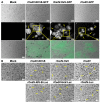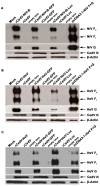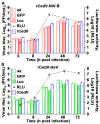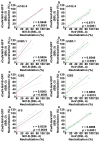A Recombinant Chimeric Cedar Virus-Based Surrogate Neutralization Assay Platform for Pathogenic Henipaviruses
- PMID: 37243163
- PMCID: PMC10223282
- DOI: 10.3390/v15051077
A Recombinant Chimeric Cedar Virus-Based Surrogate Neutralization Assay Platform for Pathogenic Henipaviruses
Abstract
The henipaviruses, Nipah virus (NiV), and Hendra virus (HeV) can cause fatal diseases in humans and animals, whereas Cedar virus is a nonpathogenic henipavirus. Here, using a recombinant Cedar virus (rCedV) reverse genetics platform, the fusion (F) and attachment (G) glycoprotein genes of rCedV were replaced with those of NiV-Bangladesh (NiV-B) or HeV, generating replication-competent chimeric viruses (rCedV-NiV-B and rCedV-HeV), both with and without green fluorescent protein (GFP) or luciferase protein genes. The rCedV chimeras induced a Type I interferon response and utilized only ephrin-B2 and ephrin-B3 as entry receptors compared to rCedV. The neutralizing potencies of well-characterized cross-reactive NiV/HeV F and G specific monoclonal antibodies against rCedV-NiV-B-GFP and rCedV-HeV-GFP highly correlated with measurements obtained using authentic NiV-B and HeV when tested in parallel by plaque reduction neutralization tests (PRNT). A rapid, high-throughput, and quantitative fluorescence reduction neutralization test (FRNT) using the GFP-encoding chimeras was established, and monoclonal antibody neutralization data derived by FRNT highly correlated with data derived by PRNT. The FRNT assay could also measure serum neutralization titers from henipavirus G glycoprotein immunized animals. These rCedV chimeras are an authentic henipavirus-based surrogate neutralization assay that is rapid, cost-effective, and can be utilized outside high containment.
Keywords: Cedar virus; Hendra virus; Nipah virus; antibody; chimera; henipavirus; reverse genetics; serum; vaccine; virus neutralization; virus-host cell interaction.
Conflict of interest statement
C.C.B is a United States federal employee and co-inventor on United States and foreign patents pertaining to soluble forms of Nipah virus and Hendra virus G glycoproteins, and Cedar Virus and Methods of Use, whose assignees are the United States as represented by the Henry M. Jackson Foundation for the Advancement of Military Medicine, Inc. (Bethesda, MD, USA). All other authors declare no conflict of interest.
Figures












References
-
- Wang L.-F., Mackenzie J.S., Broder C.C. Henipaviruses. In: Knipe D.M., Howley P.M., editors. Fields Virology. Volume 1. Lippincott Williams & Wilkins; Philadelphia, PA, USA: 2013. pp. 1070–1085.
-
- Lee S.H., Kim K., Kim J., No J.S., Park K., Budhathoki S., Lee S.H., Lee J., Cho S.H., Cho S., et al. Discovery and Genetic Characterization of Novel Paramyxoviruses Related to the Genus Henipavirus in Crocidura Species in the Republic of Korea. Viruses. 2021;13:2020. doi: 10.3390/v13102020. - DOI - PMC - PubMed
Publication types
MeSH terms
Substances
Supplementary concepts
Grants and funding
LinkOut - more resources
Full Text Sources

